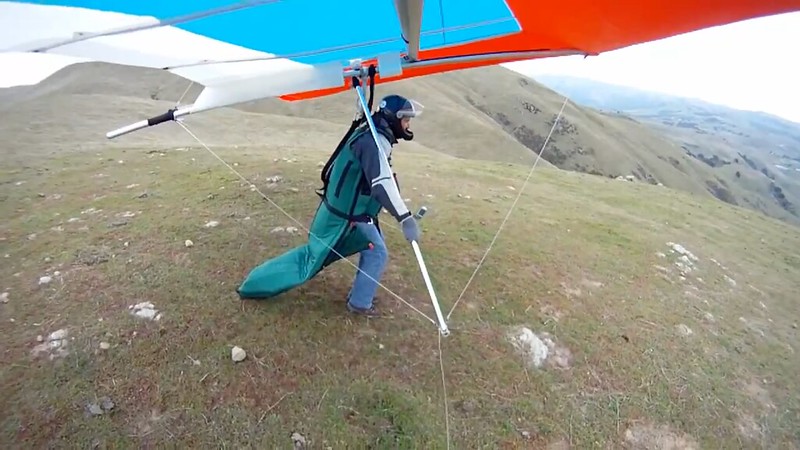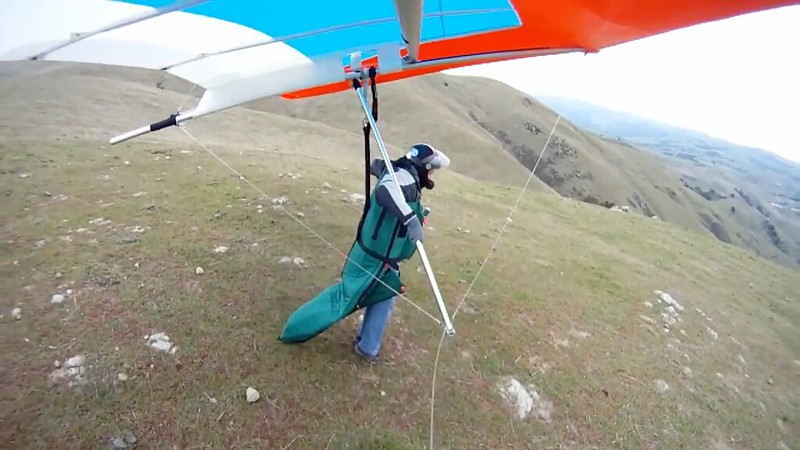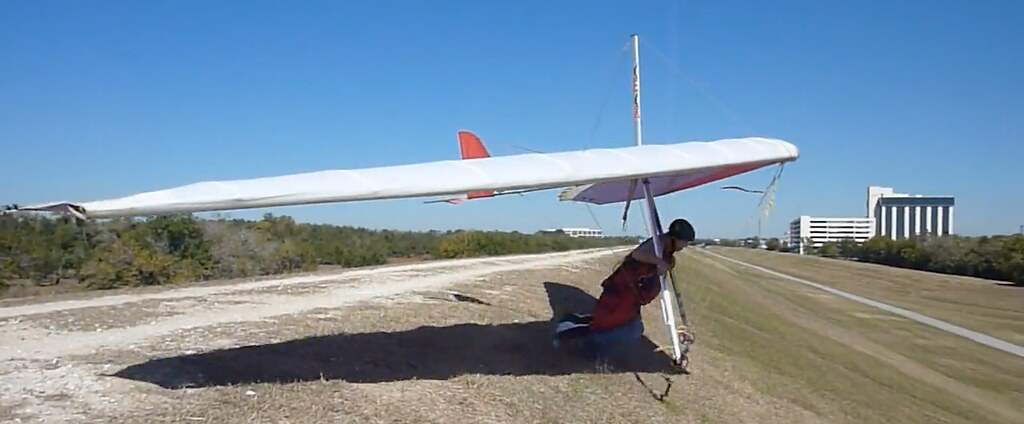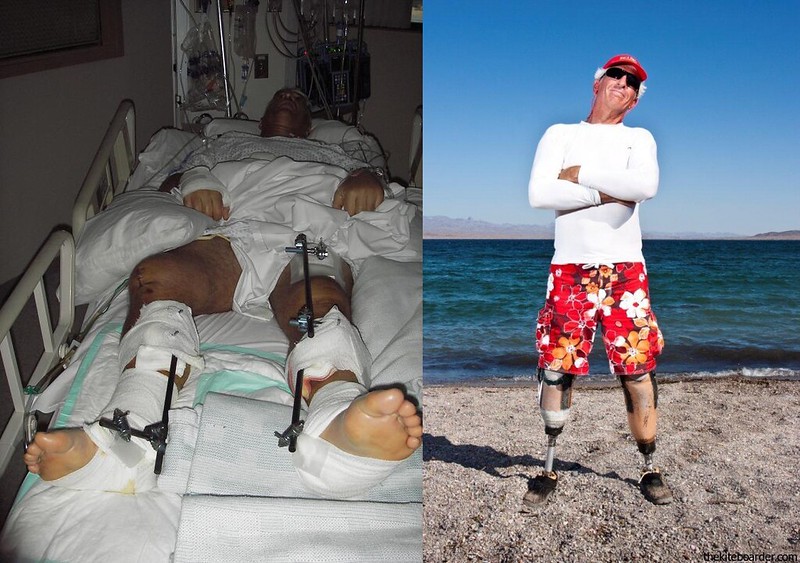I launched with my harness UNBUCKLED
Try "legs not in leg loops". We've got way too much use-whatever-the-fuck-word-you-feel-like in this sport already.Steve Seibel - 2013/10/03 04:59:31 UTC
launching with feet not in leg loops
Cape Lookout, OregonHere was my launch without leg loops at a coastal site...
ALL landings on the wheels are good ones....a couple years ago. Note the huge PIO's as I tried to kick my legs up into the boot and things didn't feel right at all-- why was the boot so much higher than usual? Finally got my feet into the boot and zipped up.
http://vimeo.com/11287860
Went on to have a nice long flight
http://vimeo.com/11287969
And a good landing on the wheels, without unzipping
There were no CONTRIBUTING FACTORS that caused this problem. You ELECTED TO forego the easiest and most effective method of satisfying USHGA's then nearly three decade old regulation mandating a hook-in check just prior to launch.http://vimeo.com/11288066
I did alert a pilot on the beach to "catch" me because it was windy and I was afraid it might not be so good to be stuck there prone on the ground
Contributing factors to the problem--
Funny that you should mention memory deviating from what actually happened. That's THE issue and the ONLY issue which causes unsecured launches.(now edited as I watched the video again and saw that my memory has deviated from what actually happened!)
Just how knowledgeable a helper is required for something like this?In essence, the harness was already hooked into the glider, with my radio cables connected, but I hadn't put the nose cone on yet.
I judged it too windy to put the nose cone on with the glider tail-to-the-wind, without a knowledgeable helper on the keel.
Bull fucking shit. There are ZERO crucial seconds in that video. You're not doing anything of any consequence at any time.So I slipped one shoulder into the harness and moved the glider nose-into-the-wind and slipped out of the harness and attached my nose cone.
After attaching the nose cone, I was going to move the glider back to its original sheltered position tail-to-the-wind before going through the usual process of getting in the harness. Then I would have to move the glider yet again before launching.
So again I slipped one arm into the harness and started to pick up the glider. But then I stop, and slide in the other arm, and then I do the side zipper, and the side buckles.
So, somehow, I started by thinking "I'm going to move the glider again with one shoulder in the harness"
Then maybe-- I'm not sure-- I thought "wait, it would be easier to move the glider with both shoulders in, easier on the harness as it won't drag sideways so badly"
And then I changed to thinking "Since I have a bystander here who is willing to hold the nose down, so I have both hands free, why not just get ready here leaving the glider nose-into-the-wind and save all that moving back and forth?"
And that's when I forgot why I had one shoulder in the harness, and just continued the process of getting the rest of the way into the harness, never having put my feet through the leg loops.
1:25-1:45 are the crucial seconds in the video.
(Video of routine just before launch:
http://vimeo.com/11287752
)
Yeah, why bother checking leg loops. The chances of you missing enough of them to matter are microscopic and you could so much better spend your time checking to make sure that your chinstrap is buckled, your backup loop is engaged, and your altimeter is properly set.I don't (or didn't) normally check the leg loops because it was normally so automatic for me to get into them before putting my arms into the shoulders.
1. Fuck that.The leg loops on this harness don't buckle, you have to step into them.
Spectators are distracting!
2. At 0:29 when you pick of the glider he's got his hand on your upwind wire and at that point he becomes a valuable launch assistant. And he retains that status - active or on standby - until you're off the cliff.
1. Fuck that - again.It would have been better just to put the glider back tail to the wind and climb into the harness the usual way without the distraction of a curious spectator holding the nose and chatting.
2. Name one person who flies hang gliders who wasn't first a curious spectator.
3. And I one hundred percent guarantee you that we'd:
- prevent a lot of crashes, injuries, crippling's, and deaths
- get a lot more airtime and have a lot more fun at a lot more sites and a lot less cost
- be:
-- in a state of technological advancement instead of stagnation and decay
-- a lot more effective in dealing with scum like Trisa, Matt, Davis, Rooney, Ryan
if:
- we had more non and future flyer curious spectators; and
- our current flyers, instructors, tow drivers, directors spent a lot more of their down time as curious spectators
Like a Rooney Link pop. Shoulda gone for it.It wasn't so windy that it was terribly risky to move the glider, just inconvenient.
Bullshit.Ways to help prevent:
- Put the nose cone on before hooking up the harness (I just forgot this time)
Bullshit.- Always slip on one shoulder only, not both, if you are just trying to bring the harness along with you as you move the glider on the ground. Or go ahead and get into the leg loops. Don't be in the shoulders unless you are already in the leg loops.
1. Once you decide to get help from him he's not a bystander any more - he's launch crew.- Be very cautious whenever you decide to get help from a bystander...
2. Be six times as cautious when there are no bystanders around from whom to get help.
1. Bullshit....as you are surely changing your routine and also increasing your distraction level.
2. You're DEcreasing your likelihood of getting blown over.
3. Your issue didn't have a goddam thing to do with distraction.
1. Bullshit. Take whatever time you need to preflight everything - regardless of what is or isn't going on.Take extra time to preflight everything.
2. How much extra time do you need to check the things that:
- aren't blinding obvious; and
- matter?
I'm guessing three seconds should be plenty.
1. Bullshit. Take the path of least resistance.- Don't change your routine to involve bystanders except when really necessary.
2. Fuck your routine. Try thinking for something new and different.
Yeah? How long before launch?- Check leg loops before launch, every time.
What's the maximum length of time you are one hundred percent positive that your memory hasn't deviated from what actually happened - and willing to bet your life on it?(now edited as I watched the video again and saw that my memory has deviated from what actually happened!)
Just "having a routine" isn't good enough.
Hang Gliding - 1981/05
Just Doing a Hang Check is not Enough
Article and photos by George Whitehill
Over the years I have observed the problem of pilots taking off not having hooked into their gliders. I've also read about and seen the tragic results. Some pilots have gotten lucky; most have not.
Since I believe that the only person responsible for my personal safety is myself, I've developed habits to insure that I won't make such a careless error. Wire assistants, launch assistants and my friends can never be to blame if I am forgetful. I must take the full responsibility. You must, too.
Just doing a hang check is not enough.
The point I'm trying to make is that every pilot should make a second check to be very certain of this integral part of every flight. In many flying situations a hang check is performed and then is followed by a time interval prior to actual launch. In this time interval the pilot may unconsciously unhook to adjust or check something and then forget to hook in again. This has happened many times!
If, just before committing to a launch, a second check is done every time and this is made a habit, this tragic mistake could be eliminated. Habit is the key word here. This practice must be subconscious on the part of the pilot. As we know, there are many things on the pilot's mind before launch. Especially in a competition or if conditions are radical the flyer may be thinking about so many other things that something as simple as remembering to hook in is forgotten. Relying on memory won't work as well as a deeply ingrained subconscious habit.
In the new USHGA rating system, for each flight of each task "the pilot must demonstrate a method of establishing that he/she is hooked in, just prior to launch." The purpose here is obvious.
Ya know what's REALLY, REALLY resistant to screw ups?Sooner or later you may find a way to screw it up.
A solid foundation of threat assessment. Any you'll NEVER get that through mainstream hang gliding instruction 'cause all that bullshit is geared towards making the marks feel safe about what they're doing. And you don't seem to be smart enough to break away from that programming.Rob Kells - 2005/12
Each of us agrees that it is not a particular method, but rather the fear of launching unhooked that makes us diligent to be sure we are hooked in every time before starting the launch run.
Yeah. Edited five times. And at least one - and probably all - of those was due to a memory issue.Last edited by aeroexperiments on 2013/10/03 19:25:52 UTC; edited 5 times in total
No Jack Show poster has ever died within seconds as a direct consequence of clicking a submit button. But let's say that you would be killed unless the final character was a period.
- Would you need a checklist to help you remember that issue?
- Would a checklist reduce or increase the probability of a fatal mistake?
For me this is Post 3773 on this forum. I don't wanna look any more stupid than necessary so I run virtually everything I've written through a spellcheck first. I've occasionally violated that rule for short posts and cheated on long ones by editing after pasting into the submission form but I've never once FORGOTTEN to run the check. The fear of looking more stupid is what keeps me forgetting.
And a lift and tug is a tiny fraction of the pain of running a spellcheck and can be executed inside of a second. And the consequences of not running the hook-in check can be a lot more severe. I'm totally confident that I won't ever launch unhooked or unsecured because I'm totally terrified of the likely consequences of doing so and attach zero value to my routines and memory.
People who understand the issue NEVER find ways to omit hook-in checks.
Your crucial seconds are all in THIS video:1:25-1:45 are the crucial seconds in the video.
http://vimeo.com/11287860
0:04 through 0:06 - when you're doing nothing instead of something. Those two seconds were your:
- most critical
- easiest
- best
- last
chance to catch a common issue which has killed some of your predecessors - the last less than eight months prior. All you had to do was allow the glider to float up a little - but instead you worked a little to hold it down.




